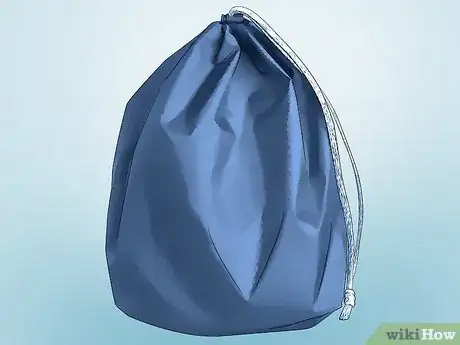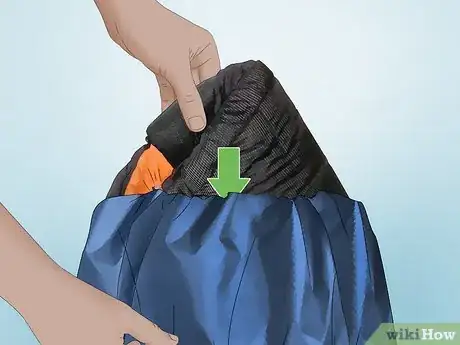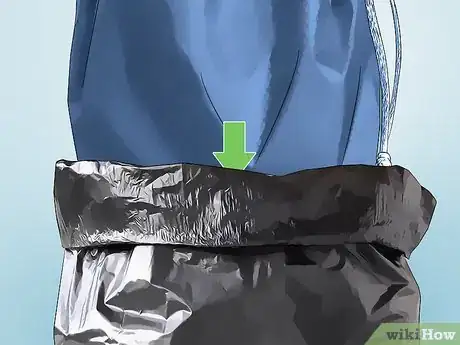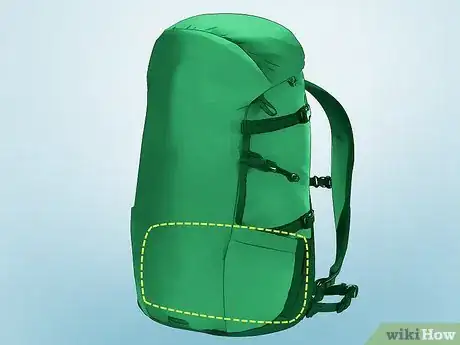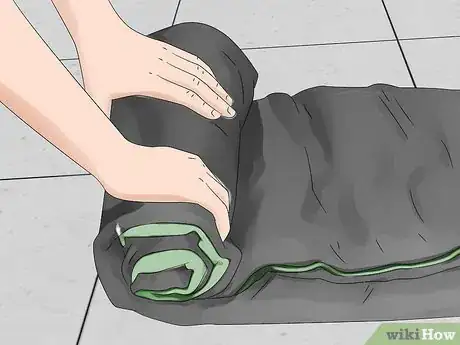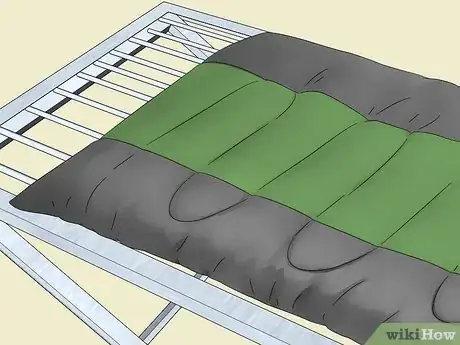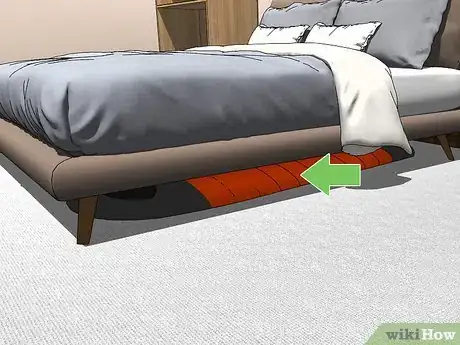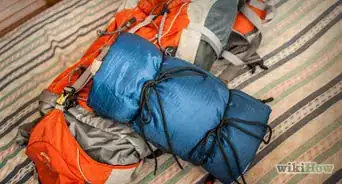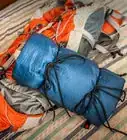This article was co-authored by Josh Goldbach. Josh Goldbach is an Outdoor Education Expert and the Executive Director of Bold Earth Adventures. Bold Earth leads adventure travel camps for teenagers all over the world. With almost 15 years of experience, Josh specializes in outdoor adventure trips for teens both in the United States and internationally. Josh earned his B.A. in Psychology from Eckerd College in St. Petersburg, Florida. He’s also trained as a wilderness first responder, a Leave No Trace master educator, and a Level 5 Swiftwater rescue technician.
This article has been viewed 78,212 times.
Improper packing can turn your cozy sleeping bag into a wet, heavy lump. Learn how to protect it and fit it comfortably in your rucksack. When you return from your adventure, don't forget to give your bag a little attention so it stays comfy for your next trip.
Steps
Packing a Sleeping Bag for Backpacking
-
1Consider getting a stuff sack so you can pack the sleeping bag in a smaller volume. One choice is a "compression sack," which has cinch straps to further compress the bag after packing.
- The minimal amount of extra weight from the sack can be worth it for the reduction in volume, and the protection against tears. However, a lot of long-distance hikers don't use a stuff sack--they just stuff the bag in their pack and let it take up empty spaces. The only reason to stuff it in a sack is to keep it contained, for convenience. Compression sacks are a good way to save space but are a little heavier than a regular stuff sack.
-
2Stuff the bag in the stuff sack. No folding, no rolling, just take one end and start stuffing it into the bag until it's all in. Starting with the foot end so it's easier to get all the air out. By "stuffing" it this way the insulation will stay more evenly distributed since it never gets folded the same way. If this is a compression sack, cinch the straps to tighten the bag further. Pull the cord on the stuff sack as tight as possible. The goal is to have there be an opening no larger than a quarter if at all possible.[1]
- Folding and rolling tends to cause repeated stress on the same parts, and can cause lumps in the stuffing or tears in the fabric. Folding also takes longer and makes it harder to compress.
Advertisement -
3Protect your bag from water. Keeping your sleeping bag dry is a major priority, especially for down bags. Nothing is more uncomfortable than sleeping in a wet bag on a cold night. Waterproof stuff sacks and rucksacks are one option, but they can be expensive and not always reliable. For extra protection, use a quality pack cover and line the interior of your pack with a trash compactor bag.[2]
- Bags can get wet not only from rain, but setting your backpack on the wet ground (since you often strap it to the bottom of your bag), or when crossing streams.
- If you don't have a trash compactor bag, line the inside of the stuff sack with a regular garbage bag before you stuff the bag in.
- Fold the top of the garbage or trash compactor bag over so that it is sealed and water won't get in. If you're using a garbage bag inside the stuff sack, twist the excess ends of the garbage bag and stick the twist under the edge of the drawstring so nothing sticks out. No need to use a twist tie. They are too easy to lose on the trail and add to trash on the trail.
-
4Pack the bag at the bottom of your pack. Since you won't need the sleeping bag during the day, pack it underneath everything else. This will also reduce strain on your back and knees, since the bag is lighter (by volume) than most other supplies.[3]
- If your pack has two compartments, store it at the bottom of the top compartment.
- If it is not possible to fit all of your gear inside the pack, and the larger items like tent and/or sleeping bag have to be lashed on outside, strap the sleeping bag to the top of the pack and the tent to the bottom. When you take the pack off at rest stops and set it on the ground, it is preferable to have the tent instead of the sleeping bag in contact with the ground, especially if it's damp or muddy.
- If you strap the bag to your backpack, be sure to try and center it on the pack as best as possible and cinch it as tight as you can. Otherwise many people end up having to stop to re-secure their bag because it is falling out.
Packing a Bag by Rolling It
This method is convenient for compressing a sleeping back to a convenient size for situations where volume is not as much of an issue, such as car camping or sleepovers.
-
1Fold the bag in half. Fold it width-wise, so it becomes half as wide and twice as thick when rolled up. Depending on the size of your bag and stuff sack, you may need to fold it a second time.[4]
-
2Roll up the sleeping bag. Start rolling at the end without straps attached. Roll the bag as tightly as you can, then pull the straps over the bundle to keep it together.
- To roll it as tightly as possible, kneel with your knees on the end of the bag, rolling it against your upper leg.
-
3Fit the bag into its sack. This usually is not a stuff sack, but a fitted sack that the sleeping bag can fit into when rolled up.[5]
- If you do not have a stuff sack, cinch the rolled up bag tight with a belt, or a string or rope as a last resort. You may need a friend to hold the bag while you tie it.
Storing a Sleeping Bag at Home
-
1Wash the bag if necessary. If the sleeping bag gets dirty, wash it in a front-loaded washing machine. Run it through the dryer until completely dry. If you have a synthetic sleeping bag, check the tag for special instructions before you do this.
- Down sleeping bags get clumpy in the wash. To make them even and fluffy again, add a tennis ball to the dryer near the end of the cycle.
- Never wash a sleeping bag in a top-loaded machine. The agitator may tear the fabric.
-
2Air out the sleeping bag after each trip. Never store a sleeping bag while it is wet or even a little damp. If the sleeping bag doesn't need a visit to the laundromat, just spread it out to dry instead.
- Some people turn the bag inside-out and hang it so that the inside airs out (that's often what gets smelly over time).
-
3Leave it uncompressed during storage. Storing a sleeping bag in a stuff sack may compress the material permanently (the stuffing inside can separate along where it's folded and this makes it colder and less warm to sleep in). Let it expand between trips with one of the following storage methods:
- Place it in an oversize, breathable storage bag made from cotton or nylon.
- Spread it out under the bed.
- Hang synthetic (but not down) sleeping bags on a large clothes hanger.
-
4Protect it from insects and water. If you're storing your sleeping bag in a damp room, place it in a bone-dry, airtight tub. Keep it away from areas with a known insect problem.
Community Q&A
-
QuestionHow should I roll it?
 Community AnswerFold it like a blanket, but make sure it is a rectangle shape and it fits so it can fit into another bag.
Community AnswerFold it like a blanket, but make sure it is a rectangle shape and it fits so it can fit into another bag. -
QuestionHow would I do this if I'm rolling it?
 Community AnswerStart with the part that's open and, as you roll it downward, press it to get all the air and fluff out.
Community AnswerStart with the part that's open and, as you roll it downward, press it to get all the air and fluff out.
Warnings
- There are many types and models of sleeping bags that these instructions may not be entirely applicable to. The most immediate example would be the old military surplus "mummy" bags often available at surplus stores. These are usually rather difficult to compress (rendering a stuff sack less than ideal), since they tend to be stiffer than their modern counterparts, and most specifically say "Do Not Wash" on an interior tag.⧼thumbs_response⧽
- If your sleeping bag gets a hole in it near the zipper, fix it immediately. The whole sleeping bag could fall apart.⧼thumbs_response⧽
References
About This Article
To pack a sleeping bag for backpacking, push it foot first into a stuff sack and sinch the straps to tighten the sack. Then, protect your sleeping bag from getting wet by lining your backpack with a trash compactor bag. Alternatively, fold the sleeping bag in half lengthwise and roll it up. Next, fit the bag into its sack and pull the cord tight. Finally, place the bag at the bottom of your pack, since you won’t need it during the day. For tips on how to store a sleeping bag at home, keep reading!
